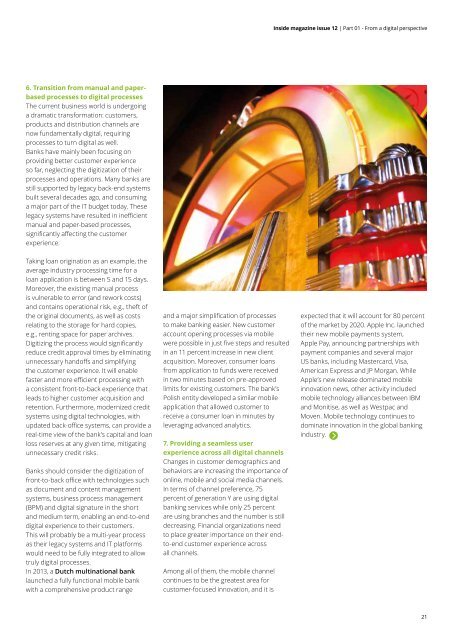lu_inside12-full
Create successful ePaper yourself
Turn your PDF publications into a flip-book with our unique Google optimized e-Paper software.
Inside magazine issue 12 | Part 01 - From a digital perspective<br />
6. Transition from manual and paperbased<br />
processes to digital processes<br />
The current business world is undergoing<br />
a dramatic transformation: customers,<br />
products and distribution channels are<br />
now fundamentally digital, requiring<br />
processes to turn digital as well.<br />
Banks have mainly been focusing on<br />
providing better customer experience<br />
so far, neglecting the digitization of their<br />
processes and operations. Many banks are<br />
still supported by legacy back-end systems<br />
built several decades ago, and consuming<br />
a major part of the IT budget today. These<br />
legacy systems have resulted in inefficient<br />
manual and paper-based processes,<br />
significantly affecting the customer<br />
experience.<br />
Taking loan origination as an example, the<br />
average industry processing time for a<br />
loan application is between 5 and 15 days.<br />
Moreover, the existing manual process<br />
is vulnerable to error (and rework costs)<br />
and contains operational risk, e.g., theft of<br />
the original documents, as well as costs<br />
relating to the storage for hard copies,<br />
e.g., renting space for paper archives.<br />
Digitizing the process would significantly<br />
reduce credit approval times by eliminating<br />
unnecessary handoffs and simplifying<br />
the customer experience. It will enable<br />
faster and more efficient processing with<br />
a consistent front-to-back experience that<br />
leads to higher customer acquisition and<br />
retention. Furthermore, modernized credit<br />
systems using digital technologies, with<br />
updated back-office systems, can provide a<br />
real-time view of the bank’s capital and loan<br />
loss reserves at any given time, mitigating<br />
unnecessary credit risks.<br />
Banks should consider the digitization of<br />
front-to-back office with technologies such<br />
as document and content management<br />
systems, business process management<br />
(BPM) and digital signature in the short<br />
and medium term, enabling an end-to-end<br />
digital experience to their customers.<br />
This will probably be a multi-year process<br />
as their legacy systems and IT platforms<br />
would need to be <strong>full</strong>y integrated to allow<br />
truly digital processes.<br />
In 2013, a Dutch multinational bank<br />
launched a <strong>full</strong>y functional mobile bank<br />
with a comprehensive product range<br />
and a major simplification of processes<br />
to make banking easier. New customer<br />
account opening processes via mobile<br />
were possible in just five steps and resulted<br />
in an 11 percent increase in new client<br />
acquisition. Moreover, consumer loans<br />
from application to funds were received<br />
in two minutes based on pre-approved<br />
limits for existing customers. The bank’s<br />
Polish entity developed a similar mobile<br />
application that allowed customer to<br />
receive a consumer loan in minutes by<br />
leveraging advanced analytics.<br />
7. Providing a seamless user<br />
experience across all digital channels<br />
Changes in customer demographics and<br />
behaviors are increasing the importance of<br />
online, mobile and social media channels.<br />
In terms of channel preference, 75<br />
percent of generation Y are using digital<br />
banking services while only 25 percent<br />
are using branches and the number is still<br />
decreasing. Financial organizations need<br />
to place greater importance on their endto-end<br />
customer experience across<br />
all channels.<br />
Among all of them, the mobile channel<br />
continues to be the greatest area for<br />
customer-focused innovation, and it is<br />
expected that it will account for 80 percent<br />
of the market by 2020. Apple Inc. launched<br />
their new mobile payments system,<br />
Apple Pay, announcing partnerships with<br />
payment companies and several major<br />
US banks, inc<strong>lu</strong>ding Mastercard, Visa,<br />
American Express and JP Morgan. While<br />
Apple’s new release dominated mobile<br />
innovation news, other activity inc<strong>lu</strong>ded<br />
mobile technology alliances between IBM<br />
and Monitise, as well as Westpac and<br />
Moven. Mobile technology continues to<br />
dominate innovation in the global banking<br />
industry.<br />
21


